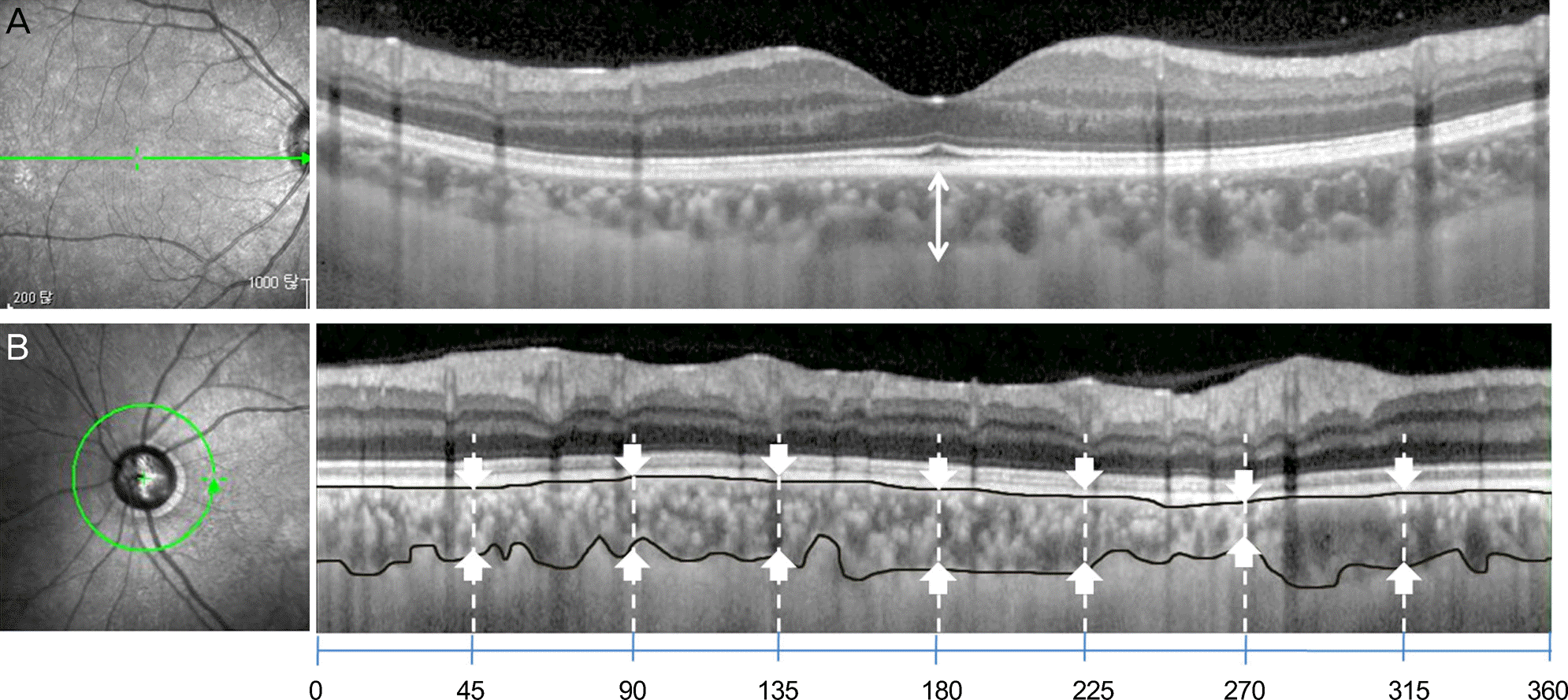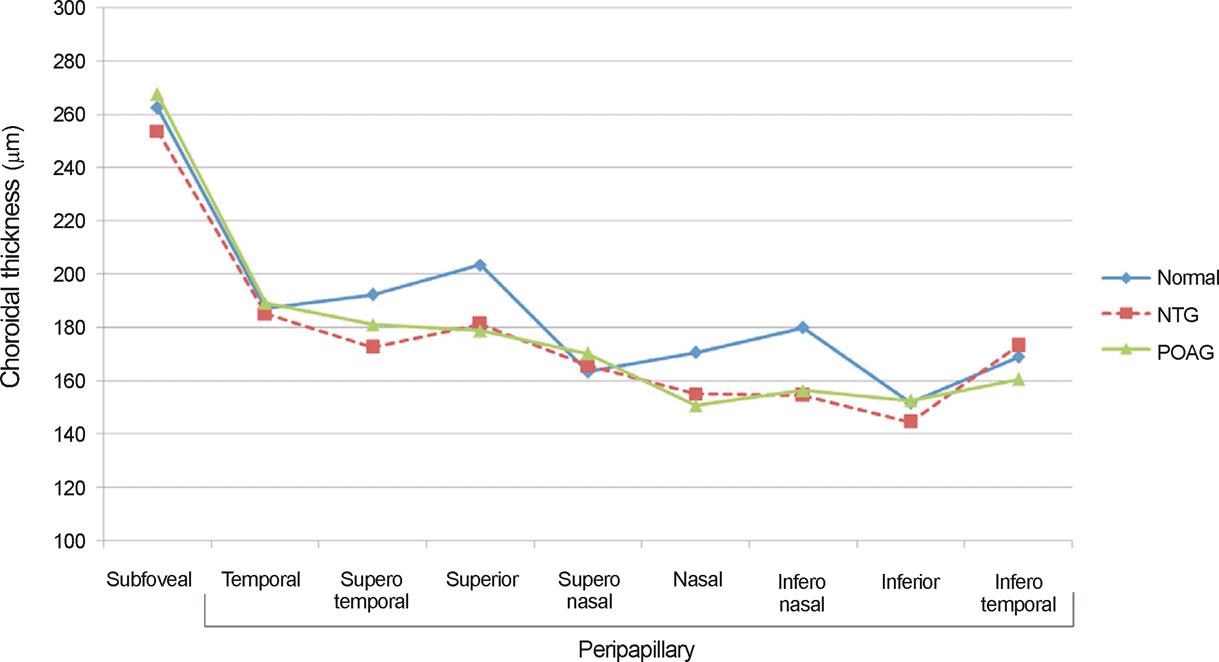1. Kim CS, Seong GJ, Lee NH, Song KC. Prevalence of primary open-angle glaucoma in central South Korea the Namilstudy. Ophthalmology. 2011; 118:1024–30.
2. Cioffi GA, Wang L, Fortune B, et al. Chronic ischemia induces re-gional axonal damage in experimental primate optic neuropathy. Arch Ophthalmol. 2004; 122:1517–25.
3. Duijm HF, van den Berg TJ, Greve EL. Choroidal haemodynamics in glaucoma. Br J Ophthalmol. 1997; 81:735–42.

4. Fuchsjäger-Mayrl G, Wally B, Georgopoulos M, et al. Ocular blood flow and systemic blood pressure in patients with primary open-angle glaucoma and ocular hypertension. Invest Ophthalmol Vis Sci. 2004; 45:834–9.
5. Hayreh SS. Blood supply of the optic nerve head and its role in op-tic atrophy, glaucoma, and oedema of the optic disc. Br J Ophthalmol. 1969; 53:721–48.

6. Spaide RF, Koizumi H, Pozzoni MC. Enhanced depth imaging spectral-domain optical coherence tomography. Am J Ophthalmol. 2008; 146:496–500.

7. Ehrlich JR, Peterson J, Parlitsis G, et al. Peripapillary choroidal thickness in glaucoma measured with optical coherence tomography. Exp Eye Res. 2011; 92:189–94.

8. Flammer J, Orgül S, Costa VP, et al. The impact of ocular blood flow in glaucoma. Prog Retin Eye Res. 2002; 21:359–93.

9. Spraul CW, Lang GE, Lang GK, Grossniklaus HE. Morphometric changes of the chorio capillaris and the choroidal vasculature in eyes with advanced glaucomatous changes. Vision Res. 2002; 42:923–32.
10. Yin ZQ, Vaegan , Millar TJ, et al. Widespread choroidal insufficiency in primary open-angle glaucoma. J Glaucoma. 1997; 6:23–32.

11. Cristini G, Cennamo G, Daponte P. Choroidal thickness in primary glaucoma. Ophthalmologica. 1991; 202:81–5.

12. Drexler W, Morgner U, Ghanta RK, et al. Ultrahigh-resolution ophthalmic optical coherence tomography. Nat Med. 2001; 7:502–7.

13. Mwanza JC, Hochberg JT, Banitt MR, et al. Lack of association be-tween glaucoma and macular choroidal thickness measured with enhanced depth-imaging optical coherence tomography. Invest Ophthalmol Vis Sci. 2011; 52:3430–5.

14. Maul EA, Friedman DS, Chang DS, et al. Choroidal thickness measured by spectral domain optical coherence tomography: fac-tors affecting thickness in glaucoma patients. Ophthalmology. 2011; 118:1571–9.
15. Usui S, Ikuno Y, Miki A, et al. Evaluation of the choroidal thick-ness using high penetration optical coherence tomography with long wavelength in highly myopic normal-tension glaucoma. Am J Ophthalmol. 2012; 153:10–6.e1.
16. Hirooka K, Tenkumo K, Fujiwara A, et al. Evaluation of peripapil-lary choroidal thickness in patients with normal-tension glaucoma. BMC Ophthalmol. 2012; 12:29.

17. Sogawa K, Nagaoka T, Takahashi A, et al. Relationship between choroidal thickness and choroidal circulation in healthy young subjects. Am J Ophthalmol. 2012; 153:1129–32.e1.

18. Fujiwara A, Shiragami C, Shirakata Y, et al. Enhanced depth imaging spectral domain optical coherence tomography of subfoveal choroidal thickness in normal Japanese eyes. Jpn J Ophthalmol. 2012; 56:230–5.
19. Ho J, Branchini L, Regatieri C, et al. Analysis of normal peripapil-lary choroidal thickness via spectral domain optical coherence tomography. Ophthalmology. 2011; 118:2001–7.

20. Manjunath V, Taha M, Fujimoto JG, Duker JS. Choroidal thickness in normal eyes measured using Cirrus HD optical coherence tomography. Am J Ophthalmol. 2010; 150:325–9.e1.

21. Suh W, Cho HK, Kee C. Evaluation of peripapillary choroidal thickness in unilateral normal-tension glaucoma. Jpn J Ophthalmol. 2014; 58:62–7.

22. Kim JM, Jeoung JW, Bitrian E, et al. Comparison of clinical char-acteristics between Korean and Western normal-tension glaucoma patients. Am J Ophthalmol. 2013; 155:852–7.

23. Mwanza JC, Sayyad FE, Budenz DL. Choroidal thickness in uni-lateral advanced glaucoma. Invest Ophthalmol Vis Sci. 2012; 53:6695–701.

24. Rhew JY, Kim YT, Choi KR. Measurement of subfoveal choroidal thickness in normal-tension glaucoma in Korean patients. J Glaucoma. 2014; 23:46–9.

25. Schuman JS. Spectral domain optical coherence tomography for glaucoma (an AOS thesis). Trans Am Ophthalmol Soc. 2008; 106:426–58.
26. Chung HJ, Park CK. Factors determining the peripapillary retinal nerve fiber distribution. J Glaucoma. 2013; Aug 21. [Epub ahead of print].

27. Kim NR, Hong S, Kim JH, et al. Comparison of macular ganglion cell complex thickness by Fourier-domain OCT in normal tension glaucoma and primary open-angle glaucoma. J Glaucoma. 2013; 22:133–9.

28. Curcio CA, Allen KA. Topography of ganglion cells in human retina. J Comp Neurol. 1990; 300:5–25.

29. Zeimer R, Asrani S, Zou S, et al. Quantitative detection of glau-comatous damage at the posterior pole by retinal thickness mapping. A pilot study. Ophthalmology. 1998; 105:224–31.
30. Leung CK, Chan WM, Yung WH, et al. Comparison of macular and peripapillary measurements for the detection of glaucoma: an optical coherence tomography study. Ophthalmology. 2005; 112:391–400.






 PDF
PDF ePub
ePub Citation
Citation Print
Print


 XML Download
XML Download